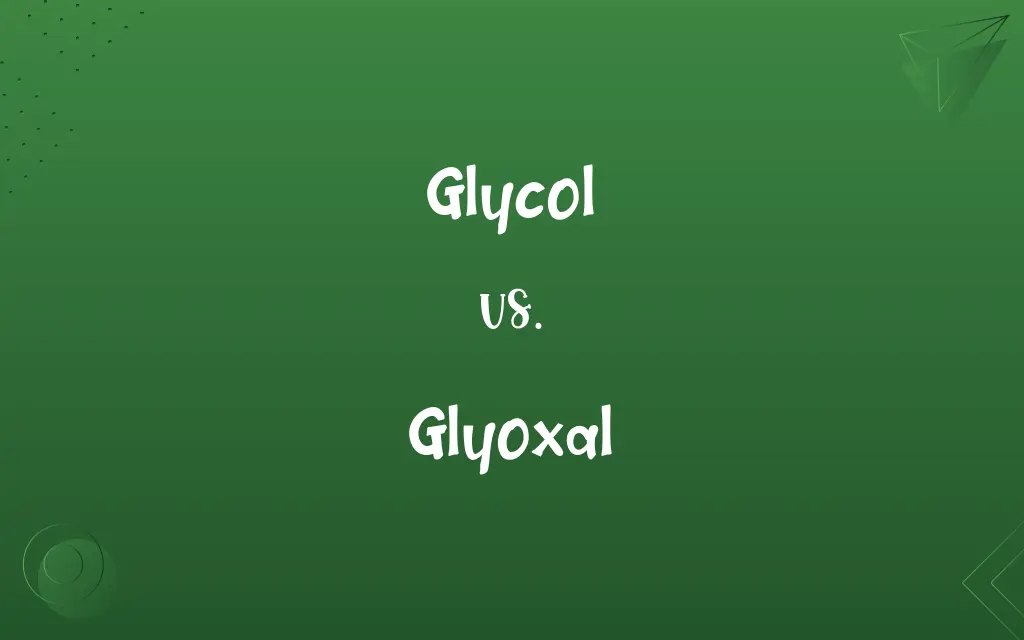Glycol vs. Glyoxal: Know the Difference

By Shumaila Saeed || Published on January 5, 2024
Glycol is a diol with two hydroxyl groups, commonly used as an antifreeze, while Glyoxal is an aldehyde with two carbonyl groups, used in textiles and paper production.

Key Differences
Glycol is a type of organic compound known as a diol, meaning it has two hydroxyl (-OH) groups. It is most commonly referred to in the context of ethylene glycol, a colorless, sweet-tasting liquid used in antifreeze and as a coolant in engines. Glyoxal, on the other hand, is an organic compound belonging to the aldehyde group, characterized by its two aldehyde (-CHO) groups. It is a yellowish liquid used primarily in textile and paper industries for crosslinking polymers and improving paper wet strength.
Shumaila Saeed
Jan 05, 2024
In terms of chemical structure, glycol molecules are generally more stable and less reactive compared to glyoxal. This stability is due to the presence of hydroxyl groups in glycols, which are less reactive than the aldehyde groups found in glyoxals. Glycols are often used as a constituent in various chemical reactions due to their stability, whereas glyoxals are used as a reactive intermediate in chemical synthesis.
Shumaila Saeed
Jan 05, 2024
The applications of glycol and glyoxal significantly differ due to their distinct chemical properties. Glycol is widely used in industries such as automotive for antifreeze formulations, whereas glyoxal finds its application in the textile industry for fabric treatment and paper industry for improving the strength and quality of paper.
Shumaila Saeed
Jan 05, 2024
In terms of toxicity, glycol, especially ethylene glycol, is moderately toxic and can be harmful if ingested, leading to renal failure and central nervous system depression. Glyoxal, while also toxic, primarily poses risks as an irritant to the skin, eyes, and respiratory system.
Shumaila Saeed
Jan 05, 2024
Environmental impact is another differentiating factor. Glycol contamination, especially from antifreeze leakage, can be a significant environmental concern, affecting water quality and wildlife. Glyoxal is also a pollutant but is more known for its contribution to air quality issues, particularly in its role in the formation of secondary organic aerosols.
Shumaila Saeed
Jan 05, 2024
ADVERTISEMENT
Comparison Chart
Toxicity
Moderate (renal failure if ingested)
Irritant (skin, eyes, respiratory system)
Shumaila Saeed
Jan 05, 2024
Environmental Impact
Water contamination risk
Air quality impact (secondary organic aerosols)
Shumaila Saeed
Jan 05, 2024
ADVERTISEMENT
Glycol and Glyoxal Definitions
Glycol
Glycol is used in the production of polyesters.
Polyethylene terephthalate, used in plastic bottles, is made from glycol.
Shumaila Saeed
Dec 28, 2023
Glyoxal
Glyoxal strengthens paper products.
Paper towels are more absorbent due to glyoxal treatment.
Shumaila Saeed
Dec 28, 2023
Glycol
Glycol is used as an antifreeze in cooling systems.
The car's radiator contains a mixture of water and glycol for efficient cooling.
Shumaila Saeed
Dec 28, 2023
Glyoxal
Glyoxal crosslinks polymers in textiles.
Glyoxal is used to improve the wrinkle resistance of cotton fabrics.
Shumaila Saeed
Dec 28, 2023
Glycol
Glycol serves as a solvent in various industrial processes.
Glycol is used as a solvent in the paint industry.
Shumaila Saeed
Dec 28, 2023
ADVERTISEMENT
Glyoxal
Glyoxal is a precursor in various chemical syntheses.
Glyoxal is used in the synthesis of pharmaceuticals.
Shumaila Saeed
Dec 28, 2023
Glycol
Glycol absorbs water from the air.
Glycol is added to natural gas pipelines to prevent water vapor condensation.
Shumaila Saeed
Dec 28, 2023
Glyoxal
Glyoxal is sometimes used in food flavoring.
Glyoxal contributes to the flavor profile of certain baked goods.
Shumaila Saeed
Dec 28, 2023
Glycol
Glycol can dehydrate specific substances.
Glycol is used to dehydrate natural gas during processing.
Shumaila Saeed
Dec 28, 2023
Glyoxal
Glyoxal serves as a less toxic substitute for formaldehyde.
Glyoxal is used in adhesives as a safer alternative to formaldehyde.
Shumaila Saeed
Dec 28, 2023
Glyoxal
(organic compound) The dialdehyde ethanedial derived from ethylene glycol; it is used in the preparation of modified starch for the paper industry.
Shumaila Saeed
Dec 27, 2023
Glyoxal
A white, amorphous, deliquescent powder, (CO.H)2, obtained by the partial oxidation of glycol. It is a double aldehyde, between glycol and oxalic acid.
Shumaila Saeed
Dec 27, 2023
Glycol
(organic compound) A thick, colourless liquid, C2H4(OH)2, of a sweetish taste, produced artificially from certain ethylene compounds and used as an antifreeze; ethylene glycol.
Shumaila Saeed
Dec 27, 2023
Glycol
A thick, colorless liquid, C2H4(OH)2, of a sweetish taste, produced artificially from certain ethylene compounds. It is a diacid alcohol, intermediate between ordinary ethyl alcohol and glycerin.
Shumaila Saeed
Dec 27, 2023
Glycol
A sweet but poisonous syrupy liquid used as an antifreeze and solvent
Shumaila Saeed
Dec 27, 2023
Glycol
Any of a class of alcohols having 2 hydroxyl groups in each molecule
Shumaila Saeed
Dec 27, 2023
Repeatedly Asked Queries
Is Glycol toxic?
Yes, Glycol, especially ethylene glycol, can be toxic if ingested.
Shumaila Saeed
Jan 05, 2024
Can Glycol be used in food?
Certain forms of glycol, like propylene glycol, are used in food processing.
Shumaila Saeed
Jan 05, 2024
What industries use Glycol extensively?
Automotive, industrial cooling, and plastic manufacturing industries use glycol.
Shumaila Saeed
Jan 05, 2024
What is the environmental impact of Glyoxal?
Glyoxal contributes to air quality issues and the formation of secondary organic aerosols.
Shumaila Saeed
Jan 05, 2024
Is Glycol biodegradable?
Yes, glycols are generally biodegradable but can be environmentally harmful in large quantities.
Shumaila Saeed
Jan 05, 2024
What is the primary use of Glyoxal?
Glyoxal is primarily used in the textile and paper industries for crosslinking polymers.
Shumaila Saeed
Jan 05, 2024
Is Glyoxal a hazardous material?
Glyoxal can be hazardous as it is an irritant to the skin, eyes, and respiratory system.
Shumaila Saeed
Jan 05, 2024
Can Glyoxal be found in consumer products?
Yes, it's found in some consumer products like adhesives and personal care items.
Shumaila Saeed
Jan 05, 2024
Is Glyoxal used in food packaging?
Yes, it can be used in food packaging materials.
Shumaila Saeed
Jan 05, 2024
What is Glycol primarily used for?
Glycol is commonly used as an antifreeze and coolant.
Shumaila Saeed
Jan 05, 2024
How does Glycol affect the freezing point of water?
Glycol lowers the freezing point of water, making it effective as an antifreeze.
Shumaila Saeed
Jan 05, 2024
Are Glycol and Glyoxal interchangeable in industrial processes?
No, they have different properties and uses in industry.
Shumaila Saeed
Jan 05, 2024
Is Glyoxal more reactive than Glycol?
Yes, Glyoxal is more reactive due to its aldehyde groups.
Shumaila Saeed
Jan 05, 2024
Can Glycol be used as a dehydrating agent?
Yes, glycol can absorb water and act as a dehydrating agent.
Shumaila Saeed
Jan 05, 2024
Does Glyoxal contribute to indoor air pollution?
Yes, glyoxal can contribute to indoor air pollution in enclosed spaces.
Shumaila Saeed
Jan 05, 2024
Can Glycol be used in pharmaceuticals?
Yes, certain glycols are used as solvents in pharmaceutical formulations.
Shumaila Saeed
Jan 05, 2024
What safety precautions are necessary when handling Glyoxal?
Protective equipment like gloves and goggles are recommended due to its irritant nature.
Shumaila Saeed
Jan 05, 2024
Is Glycol harmful to aquatic life?
Yes, glycol can be harmful to aquatic life if it contaminates water bodies.
Shumaila Saeed
Jan 05, 2024
Does Glyoxal have any role in flavoring food?
Glyoxal is sometimes used as a flavoring agent in food products.
Shumaila Saeed
Jan 05, 2024
Can Glycol be used in cosmetics?
Yes, certain types of glycols are used in cosmetic formulations.
Shumaila Saeed
Jan 05, 2024
Share this page
Link for your blog / website
HTML
Link to share via messenger
About Author
Written by
Shumaila SaeedShumaila Saeed, an expert content creator with 6 years of experience, specializes in distilling complex topics into easily digestible comparisons, shining a light on the nuances that both inform and educate readers with clarity and accuracy.








































































